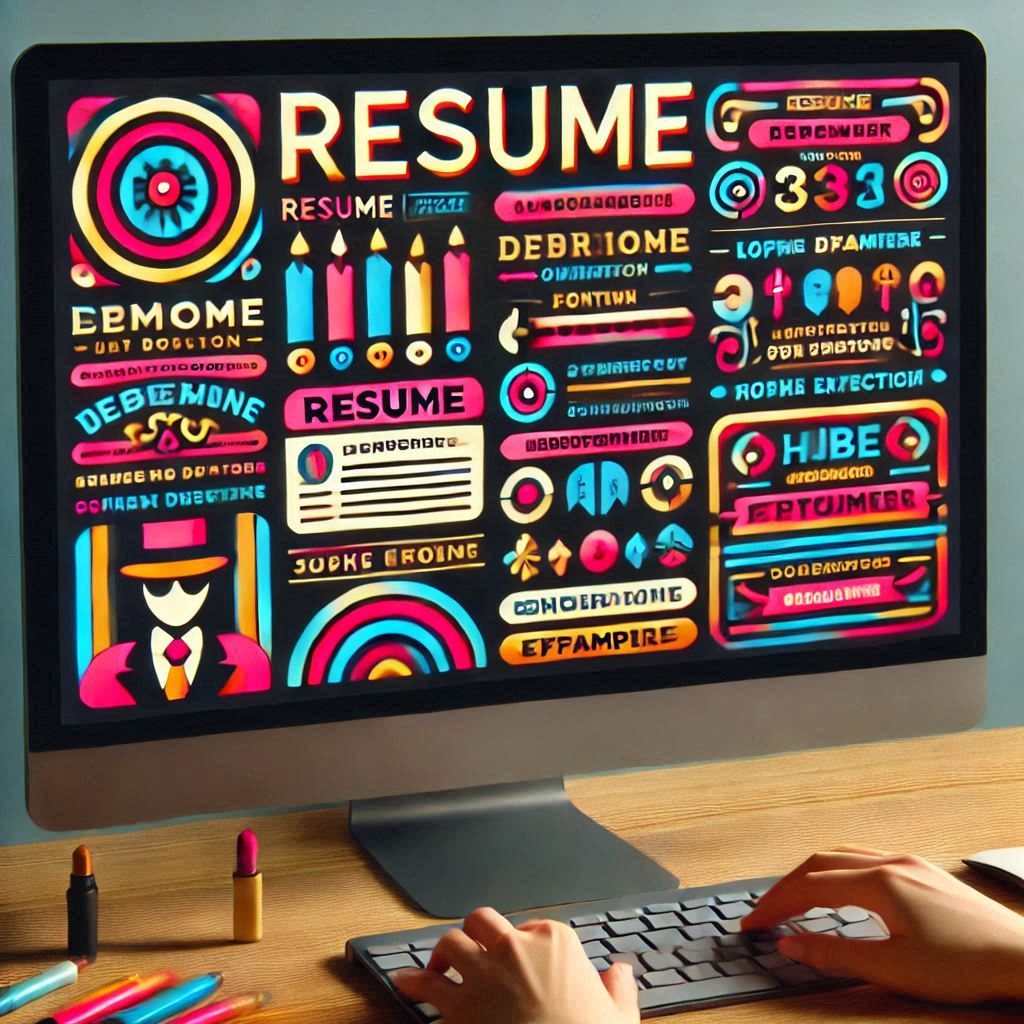Make your resume stand out with the right colors and fonts.
- Enhance readability: Use clear fonts and avoid distracting colors.
- Highlight key information: Use color and bolding strategically.
- Maintain professionalism: Choose colors and fonts appropriate for your industry.
CVKOM helps you create a visually appealing resume that gets noticed.
How to
Format Your Resume with Colors and Fonts
The design of your resume plays a
crucial role in making a strong first impression. Using colors and fonts
effectively can enhance readability, highlight key information, and convey
professionalism. However, it's important to strike a balance to avoid overloading
your resume with design elements. At CVKOM, we provide expert tips to
help you create a visually appealing and professional resume. Here's how to
format your resume with colors and fonts.
1.
Keep It Professional
Your resume should look polished and
professional. While adding colors and fonts can make it visually appealing,
it’s essential to avoid styles that look too casual or distracting.
Key Points to Consider:
- Choose colors and fonts that are appropriate for your
industry.
- Keep the design clean and easy to read.
- Avoid using more than two font styles or three colors.
2.
Choose the Right Colors
Colors can help draw attention to
specific sections of your resume, such as headings, key achievements, or
contact information. However, they should not overpower the content.
Tips for Choosing Colors:
- Stick to Neutral and Subtle Shades: Use navy blue, dark gray, or soft accents like teal or
burgundy.
- Limit the Color Palette: Use one or two colors to maintain a cohesive and
professional look.
- Consider Industry Norms: Creative industries like marketing or design may allow
for more vibrant colors, while corporate roles require a more subdued
palette.
Example:
- Main text:
Black or dark gray.
- Headings:
Navy blue or bold black.
- Accents (lines or bullets): Light gray or teal.
3.
Select Professional Fonts
Fonts are critical for ensuring your
resume is legible and professional. The right font choice reflects your
attention to detail and ensures your resume is easy to read.
Recommended Fonts:
- Sans-serif fonts:
Calibri, Arial, Helvetica, Verdana (modern and clean).
- Serif fonts:
Times New Roman, Garamond, Georgia (traditional and formal).
Font Tips:
- Use one font style throughout, or pair one sans-serif
font for headings with a serif font for body text.
- Keep font sizes between 10 and 12 points for body text
and slightly larger (14–16 points) for headings.
- Avoid decorative or overly stylized fonts like Comic
Sans or Papyrus.
4.
Use Consistent Formatting
Consistency is key to a polished and
professional resume. Ensure the same font, size, and color scheme are applied
throughout the document.
Example Formatting:
- Headings:
Bold, larger font size (e.g., 14 points), and colored.
- Body text:
Regular font style, 10–12 points, and black or dark gray.
- Emphasis (skills, achievements): Bold or italic for keywords, using the accent color
sparingly.
5.
Highlight Key Sections with Design Elements
Colors and fonts can be used
strategically to make important sections, such as your contact details, skills,
or achievements, stand out.
Examples of Design Elements:
- Contact Information:
Use a bold or colored font for your name and section headers.
- Section Dividers:
Use colored horizontal lines to separate sections.
- Icons or Symbols:
Use subtle icons for contact information, such as a phone or email icon,
but avoid overusing graphics.
6.
Maintain Readability
While design elements are important,
readability should always come first. Ensure that your resume is clear and easy
to scan quickly.
Tips for Readability:
- Use enough white space to avoid clutter.
- Avoid bright colors that strain the eyes.
- Ensure there is sufficient contrast between the text
and background colors.
7.
Adapt Your Design to ATS Compatibility
Many companies use Applicant Tracking Systems (ATS) to scan resumes. Overly complex designs, including
certain fonts or graphics, may not be ATS-friendly. If you’re submitting your
resume online, use ATS-compatible formatting.
ATS-Friendly Tips:
- Stick to standard fonts like Arial or Times New Roman.
- Use colors sparingly, avoiding light shades that ATS
may not recognize.
- Save your resume as both a PDF and a plain-text file to
ensure compatibility.
8.
Test Your Resume Design
What to Check:
- Is the text easy to read on a screen and in print?
- Do the colors maintain their contrast when printed in
grayscale?
- Are all sections formatted consistently?
Example
of a Well-Formatted Resume
Name
and Contact Information
- Font:
Bold, 16 points, navy blue.
- Example:
John Doe
email@example.com | (123) 456-7890 | LinkedIn: linkedin.com/in/johndoe
Headings
- Font:
Bold, 14 points, black or accent color.
- Example:
Professional Experience
Body
Text
- Font:
Regular, 11 points, black.
- Example:
Developed and executed digital marketing strategies that increased website traffic by 40%.
Skills
Section
- Formatting:
Use bullets or columns with a light accent background.
- Example:
- SEO and SEM
- Project Management
- Data Analysis
Section
Dividers
- Design:
A thin horizontal line in a neutral or accent color.
Common
Mistakes to Avoid
- Using Too Many Colors: Stick to one or two complementary colors.
- Choosing Hard-to-Read Fonts: Avoid decorative or script fonts.
- Overloading with Design Elements: Focus on simplicity and readability.
- Inconsistent Formatting: Maintain uniformity in font size, color, and
alignment.
- Ignoring ATS Requirements: Balance creative design with ATS compatibility.
How
CVKOM Helps You Format Your Resume
At CVKOM, we provide tools
and resources to help you create a visually appealing and professional resume:
- Customizable Templates: Choose designs with balanced colors and fonts for different industries.
- AI-Powered Guidance:
Receive recommendations on the best formatting for your specific career
field.
- Proofreading Services: Ensure your resume is polished and professional.
Conclusion
Using colors and fonts effectively
can make your resume stand out while maintaining a professional appearance. By
selecting appropriate colors, fonts, and formatting, you can create a visually
engaging resume that highlights your qualifications and makes a strong first
impression. At CVKOM, we’re here to help you design resumes that balance
style and substance. Start building your professionally formatted resume today!




